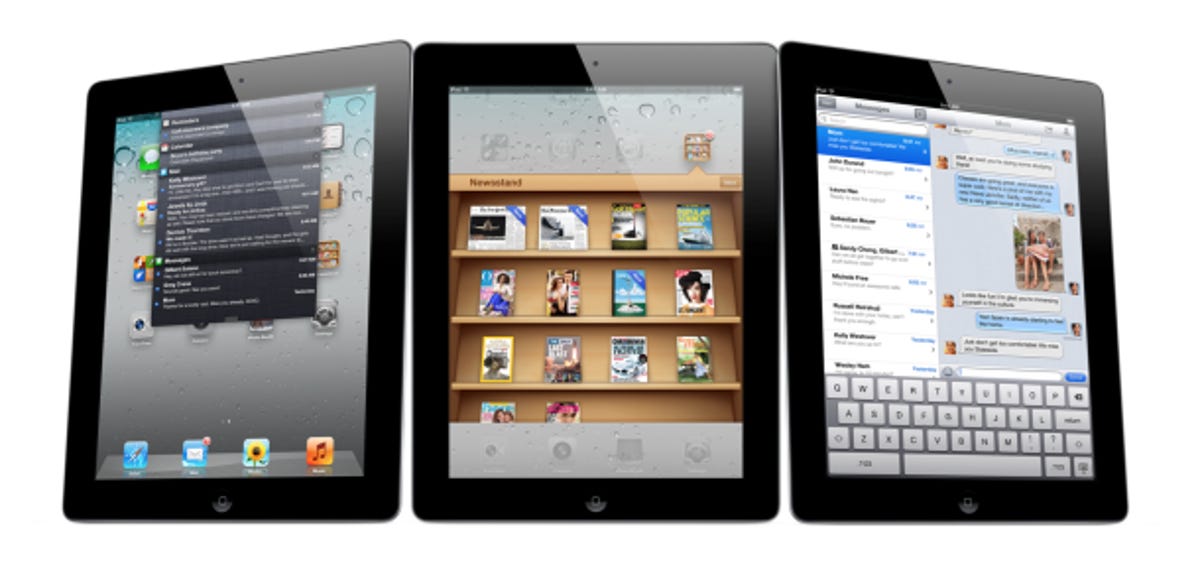
Apple
This isn’t our first rodeo. The wild, often contradictory rumors that precede an Apple product unveiling would have you thinking that the iPad 3 could take just about any form or shape. But really, so long as you don’t get hung up on the specifics, it’s fairly easy to piece together the big picture of the iPad 3. Now that we have confirmation of the event on March 7 in San Francisco, what exactly is it Apple will be unveiling?
Improved screen resolution
The rumors about the iPad 3 display are nearly unequivocal about a substantial improvement to screen resolution. In fact, the only sport left in this rumor is trying to figure out which supplier will provide the anticipated display.
Related stories
- Apple sends out invites for March 7 iPad event
- Apple iPad live blog (Wednesday, March 7)
- Top 5 iPad 3 features (video)
- All Apple iPad news
- iPad 3 rumor roundup
The resolution most often cited is QXGA, or 2,048×1,536 pixels–essentially doubling the iPad’s existing resolution. The result would be an improved realism for games, videos, photos, and e-books.
Better camera
The front and rear cameras on the iPad 2 are decent. And let’s remember, they’re a heck of a lot better than the cameras on the original iPad, which were nonexistent.
With the camera on the iPhone 4S, it’s clear that Apple considers image quality an important feature of a mobile device. With any luck, we’ll see the front-facing camera bumped up to HD quality (improving FaceTime video chat quality) and a rear camera that comes closer to iPhone quality.
iPad 3: Key feature upgrades (photos)






<!–
–>
Faster processor
Both the iPad 2 and iPhone 4S already feature Apple’s A5 processor. So what’s next? The A6, of course. Improved graphics, speed, and efficiency are the expected benefits of the A6. Graphics performance in particular will need a bump for the iPad 3 to handle all the extra pixels afforded by the improved screen.
Will the A6 be a quad-core chip? There’s good reason to question that, especially with Apple’s emphasis on battery life. Will it make the original iPad feel like molasses? Without a doubt.
4G data
Will the iPad 3 be Apple’s first 4G-compatible device? It seems likely. Apple has always offered versions of the iPad with cellular data support (priced $130 over their Wi-Fi-only siblings). With the iPad 2, Apple extended its tablet family to include iPads for both AT&T and Verizon. With both networks placing so much emphasis on their 4G data capabilities, it seems only natural that Apple would finally branch out and embrace their technology.
Siri


Apple
Now that iPhone 4S owners have exhausted the novelty of Apple’s Siri voice assistant, it seems only natural for that feature to trickle down to the iPad 3.
What’s not changing?
None of the above predictions is earth-shattering. In fact, to brace yourself for further disappointment, let’s run through the inventory of what isn’t likely to change.
Apple’s 9.7-inch screen size isn’t going anywhere. Neither is its 4:3 aspect ratio. The entire app catalog is designed around these measurements and Apple clearly hasn’t been suffering for it.
The iPad isn’t likely to get any cheaper. Yes, the competition has shown that there’s room for a low-cost tablet like the Kindle Fire, but going low-end has never been Apple’s strategy. Besides, Apple still dominates the tablet market and needn’t change what’s been working. Sure, the company may make a separate, smaller product, offer the iPad 2 hardware at a discount, or beef up the iPod Touch with a bigger screen, but the iPad 3 described above is unlikely to cost less than $499.
The iPad 3’s design is also not likely to be radically different. In the year since the iPad 2 has been on the market, only one tablet (the Asus Eee Pad Transformer Prime) has been able to match the iPad’s design in both thinness and use of premium materials. Let Samsung and Sony flail around with daring new tablet designs. If Apple can maintain the design it has while introducing an industry-defining screen technology–that’s enough.
Final thoughts
It’s tough not to run wild with iPad 3 rumors and speculation, but the most likely scenario we’ll see from Apple is an incrementally improved device that will stun users (and disrupt an industry) with a unique high-resolution display.



